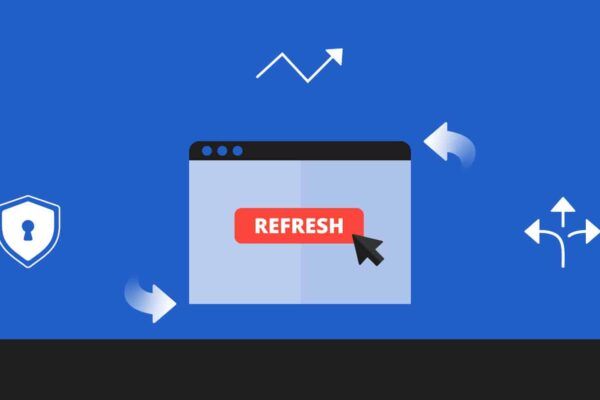
Flexibility, Security, and Privacy-First Personalization: Critical Foundations for Your Website Redesign
For many organizations, the corporate website is the hub of their digital presence. It’s the official digital home for the business, explaining the company’s vision to customers, employees, investors, partners and vendors, media and analysts, and the wider community. Customer expectations continue to evolve and a myriad of emerging technologies continue to blur the boundaries between IRL and UR. The sales, marketing, and technology leaders who own the corporate website must prioritize the digital initiatives that offer the best potential for innovation and differentiation, as well as the best return on investment.
Here are three priority areas that merit careful consideration when you are evaluating a potential corporate website redesign.
Building a website to increase flexibility, scalability, and resilience
A website redesign offers a tantalizing opportunity to build a website that is higher performing, more scalable, easier and more cost-effective to develop, or simpler to maintain over time. You might want to make use of the latest technologies, like augmented reality (AR), voice search, and AI-driven tools like chatbots and more to deliver the most compelling user experience. You can also use this opportunity to integrate and connect with third parties for fulfillment, payment services, or other value-added services that enhance your own offerings.
Whatever goals you have, the technologies you choose for your website redesign can either make it easy to evolve and adapt the website over time, or they may keep you from moving forward at all. Collectively, this technology is referred to as the website’s tech stack, and the technologies include:
- Web server: Displays the website content by storing, processing, and delivering web pages to users. Nginx and Apache account for over 60% of Internet traffic today. Web servers typically run on either Linux or Microsoft Windows machines, with most website hosting companies using Linux.
- Database engine: The repository for the website’s data, including information such as products, orders, transactions, user records, etc. The most common databases for web developers are MySQL, Microsoft SQL Server, Oracle, and Postgres.
- Programming language: Used to program business logic or build custom functionality on the website. The most common include PHP, ASP .NET, Java, and Ruby.
- Framework or platform: A group of libraries of optimized and tested code that developers use as building blocks, covering most of the common features and functions for websites so you don’t have to reinvent the wheel.
Common website tech stacks combine these elements into web server OS-based sets:
- Linux-based or LAMP: Linux, plus Apache web server, MySQL database engine, and PHP for programming language
- Windows-based or WISA: Windows, plus IIS web server, SQL Server database engine, and ASP.net for programming language
While many companies leave the tech stack decisions to the developers, it’s important that you know that you can easily find new developers to work on your website redesign for whichever technologies are chosen. The tech stack can also influence what features and functions can be easily added as your needs evolve.
Working with a custom website developer can give you access to the specialized expertise and extensive experience you need to design, develop, and deliver the technology foundations for a corporate website that will stand the test of time. From concept to deployment, Gorilla Logic partners with companies to find the best technology to serve as the foundation for their corporate website, today and in the future. We design, develop, and deploy responsive, security-first enterprise websites that combine high performance with ease of use so you can exceed customer expectations and thrive in a digital-first world.
Strengthening cybersecurity to promote trust
In a data-driven, customer-centric world, trust matters more than ever. In fact, 59% of people will stop buying a brand if they don’t trust its company. To deliver the kinds of elegant and seamless experiences customers expect, they must share data. That same increase in data sharing makes corporate websites a target for malicious actors who want to exploit that data.
While the 300% increase in cybercrimes since the start of the COVID-19 pandemic is alarming, the size of attacks is also increasing. The high-profile DDoS attack that Amazon reported in 2021, for example, was 44% larger than any previous attack. Common threats to corporate websites include:
- DNS hijacking: Hijacked DNS settings redirect an unsuspecting user to a website that visually resembles your company’s website and then use that to deliver malware.
- SQL injection attack: An attack that interferes with the queries that an application makes to the website’s database.
- Cross-site scripting: An attack that takes over a webpage to execute malicious scripts in the browser of website visitors.
- PHP injection attack: An exploit within a website’s code that malicious actors can use to take control of the web application.
- Phishing and spear-phishing attacks: Attacks designed to trick a user into revealing personal information, such as a password or credit card number, which can then be used to commit fraud or other cyber crimes.
- DoS and DDoS attacks: A Denial of Service (DOS) or Distributed Denial of Service (DDoS) attack disrupts the normal traffic of a targeted service by overwhelming it with a flood of Internet traffic.
Whether you’re planning a website redesign or rebuild, one of the most crucial considerations should be website security. Partnering with a custom software development provider can ensure that you gain the proactive mitigation, real-time visibility, and detailed plans for incident response needed to maximize the full potential of your website investment while minimizing the risks.
From vulnerability scanning and application penetration (pen) testing, to implementing identity and access management (IAM), to ensuring your ability to comply with the commercial, contractual, and legal requirements that govern your website, including PCI DSS, HIPAA, and more, Gorilla Logic is an ISO 27001 certified partner that can help you protect your data, improve compliance, reduce risks, and build trust with your customers.
Harnessing data to deliver more personal experiences in a privacy-first world
Until recently, many companies have relied on third-party cookies to target audiences, deliver tailored content, and track the performance of their digital marketing efforts. However, Google is phasing out the use of third-party cookies in Chrome by the end of 2024, and Apple has already banned them altogether. Legislators and policymakers have introduced extensive regulatory frameworks to ensure greater consumer privacy protections, such as the California Consumer Privacy Act (CCPA) and the European Union’s General Data Protection Regulation (GDPR).
In this privacy-first environment, data management has become a crucial consideration for any corporate website, and website owners must now rethink and retool how they acquire, use, secure, store, and manage user data. Many companies are responding to these changes in one or more of the following ways:
- Adopting a first-party data strategy, in which the website owner asks the user for consent to collect, store, and use data, usually in exchange for offering more tailored experiences or relevant, engaging content.
- Supplementing with a second-party data approach. While owning all of your personal data is ideal, many companies supplement by using second-party data, or data owned by another party willing to partner.
- A third option is to invest in relevant content that encourages engagement. Combined with contextual and semantic targeting, which mines the metadata of content consumed, including titles, keywords, comments, and more, this strategy can help marketing teams understand more about the user’s interests and intent.
These complex data strategies and compliance requirements lead to more complex data management systems that require careful planning and implementation. Partnering with an experienced custom web development provider like Gorilla Logic can ensure that, as part of your website refresh, you develop the supporting data strategy and infrastructure you need to securely and effectively leverage your data while protecting the privacy of your customers.
Planning a website redesign that delivers value today and tomorrow
Your corporate website refresh should ensure that you have the flexibility, security, and data management capabilities you need today, and the future-proofing you need to get the most value from your investments over time. At Gorilla Logic, we partner with you to build enterprise-grade websites and web applications from concept to deployment. Combining our decades of experience working with enterprise companies that have complex systems and requirements with our deep skills, we help you find the best solutions for your corporate website needs.


